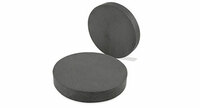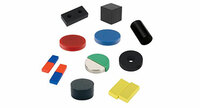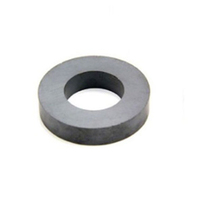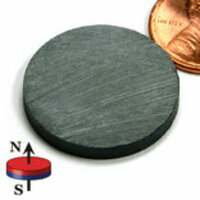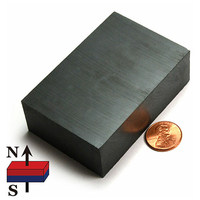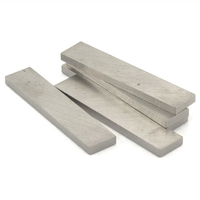Ceramic Magnets
Specifications
What Is Ceramic Magnet?
Ceramic (Ferrite) Magnet Is the Cheapest Industry Magnets
Due to relatively low-cost raw materials and an uncomplicated production process, permanent ceramic ferrite magnets are considered the most cost-effective industrial magnet with the highest output.
These ceramic neodymium bar magnets, also referred to as ceramic magnets, are presently the most common permanent magnetic material employed. Ferrite magnets are utilized in various applications,
from motors and speakers to toys and other consumer and industrial products.
Ceramic (Ferrite) Magnet Is Rust (Corrosion) Resistant Magnet
Do ceramic magnets rust? Ferrite (ceramic) magnets exhibit excellent resistance to rust and corrosion, even when submerged in water. They are highly resistant to the harmful effects of a range of
substances, including dilute acids, alkaline solutions, organic solvents, and certain hydroxides. These hard ferrite magnets attributes make them ideal for use in saline environments, as they are
not susceptible to corrosion at all. Typically, the surface of ferrite magnets does not require any electroplating treatment or protective coating.
Ferrite Permanent Ceramic Magnet Has Medium Magnetic Strength
The magnetic energy product of ferrite magnets typically ranges from 1.1MGOe to 4.0MGOe. In comparison to rare earth magnets, ferrite magnets possess a relatively weak magnetic force, although
their magnetic force is stronger in comparison to various other soft magnetic materials. As such, magnets ferrites are regarded as a permanent magnet material with medium magnetic strength. By
utilizing ferrite magnets, significant cost savings can be achieved when a very strong magnetic force is not required.
All Types Ceramic (Ferrite) Magnets For Sale-What We Can Do On Permanent Ferrite Magnets
We can provide a wide range of sizes for ceramic magnets without incurring any mold fees, which include ceramic discs, ceramic blocks (rectangular and square), and ceramic rings. A majority of
rectangular and square ceramic blocks can be readily dispatched within a short timeframe. Moreover, we can customize ceramic magnets to match your unique specifications. Please reach out to us by
submitting a quotation request or contacting us directly to inform us of your requirements. Our team will ascertain the most cost-effective solution for your project.
Details of Ceramic Magnets
Ceramic magnets (also referred to as ferrite magnets) are sintered permanent magnet materials made from SrO or BaO, and Fe2O3. MEANK ceramic magnets are made of high-quality materials and are
reliable and durable. This material can be categorized into anisotropic and isotropic ceramic magnets. The anisotropic ferrite magnet requires magnetization in one direction, while the isotropic
type can be magnetized in any direction. Although the magnetic energy product of ferrite magnets ranges from 1.1moe to 4.0moe, making them less magnetically powerful than other permanent magnets,
they exhibit strong anti-demagnetization properties and are available at a lower cost.
What Are Ceramic Magnets Used For
Ceramic (ferrite) magnets have excellent oxidation resistance and usually do not need additional protective coatings. They are the lowest cost hard magnets available at present. They are the first
choice for all kinds of consumer goods and industrial applications. Common applications of ceramic magnets include:
School Projects · Security Systems · Office Organization
· Loud Speakers · Sweeper Magnets · Home Decor
· Guitar Pick-Ups · Crafting Projects · Retail Displays
· Eddy Current Devices · Model Making · Lifting Machinery
· Breaks & Clamps · DIY Home Projects · Fridge Magnets
· Motors & Generators · Science Experiments · Apparel
· Switches · Classroom Displays · Whiteboards
· Relays · Store Signage · Promotional Gifts & more
Types Of Permanent Ceramic (Ferrite)Magnets
Ceramic Arc Magnets
Ceramic Block Magnets
Ceramic Disc Magnets
Ceramic Ring Magnets
Ceramic Cylinder Magnets
Ceramic Channel Magnets
Ferrite (Ceramic) Magnet Material Grades & Magnetic Properties
Material Grade Br HcB HcJ (BH)max Work Temp
China Standard IEC standard mT kA/m(min.) kA/m(min.) kJ/m(min.) ℃(max.)
Y10T HF 8/22 200-235 125-160 210-280 6,5-9,5 250
Y20 HF 20/19 320-380 135-190 140-195 18,0-22,0 250
Y22H HF 20/28 310-360 220-250 280-320 20,0-24,0 250
Y23 HF 22/30 320-370 170-190 190-230 20,0-25,0 250
Y25 HF 24/16 360-400 135-170 140-200 22,5-28,0 250
Y26H HF 24/23 360-390 220-250 225-255 23,0-28,0 250
Y26H-2 HF 24/35 360-380 263-288 318-350 24,0-28,0 250
Y28 HF 26/16 370-400 175-210 180-220 26,0-30,0 250
Y25H HF 26/18 360-390 175-215 215-230 24,0-27,0 250
Y28H HF 26/24 380-400 240-260 250-280 27,0-30,0 250
Y28H-2 HF 26/26 360-380 270-295 380-405 26,0-30,0 250
Y30 HF 28/16 380-385 190-210 200-220 26,0-28,0 250
Y30BH HF 28/28 380-400 230-275 235-290 27,0-32,0 250
Y30H-2 HF 30/26 395-415 275-300 310-335 28,5-32,5 250
Y32 HF 32/17 400-420 160-190 165-195 30,0-33,5 250
Y33 HF 32/22 410-430 220-250 225-255 31,5-35,0 250
Y33H HF 32/25 410-430 240-270 250-275 31,5-35,0 250
Y35 - 410-430 175-195 180-200 30,0-32,0 250
Property/Performance Parameter of Ceramic Magnets(America Standard)
Material Br HcB HcJ (BH) Max
mT KG KA/m KOe KA/m KOe Kj/m3 MGOe
C1 230 2.3 148 1.86 258 3.5 8.36 1.05
C5 380 3.8 191 2.4 199 2.5 27 3.4
C7 340 3.4 258 3.23 318 4 21.9 2.75
C8 385 3.85 235 2.95 242 3.05 27.8 3.5
C8B 420 4.2 232 2.913 236 2.96 32.8 4.12
C9 380 3.8 280 3.516 320 4.01 26.4 3.32
C10 400 4 288 3.617 280 3.51 30.4 3.82
C11 430 4.3 200 2.512 204 2.56 34.4 4.32
FAQs Of Hard Ceramic(Ferrite)Permanent Magnets
Q
Can You Supply Custom Ceramic Magnets?
A
Yes, we can supply custom ceramic magnets.We have advanced manufacturing facilities and experienced cooperation units, which can customize ceramic magnets with accurate specifications. Please
contact us or send us a quotation request today,we’ll make the best offer to you.
Q
What is the maximum working temperature of hard ferrite magnets?
A
The maximum working temperature of ferrite magnet can reach 250 ℃. When it is higher than this temperature, demagnetization will occur.
Q
What is the lowest working temperature of hard ferrite magnets?
A
The service environment of ferrite magnet has the lowest temperature limit. Demagnetization begins when the low temperature environment reaches about minus 40 degrees
Q
What are the difference between isotropic ferrite magnets and anisotropic ferrite magnets?
A
In terms of magnetic force, the of anisotropic ferrite magnets are stronger than that of isotropic ferrite magnets.In the magnetization direction, anisotropic ferrite can only be magnetized in a
specific direction, while isotropic ferrite can be magnetized in different directions.
- Country: China (Mainland)
- Business Type: Manufacturer
- Address: 1FLOOR,NO.128 BUILDING-1 128#, JIJIN ROAD,XIAOGANG,BEILUN,NINGBO
- Contact: powerful-magnets com

